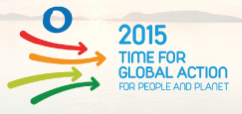The co-facilitators for intergovernmental negotiation process on the post-2015 development agenda have released a working draft of a technical report by the UN Statistical Commission (UNSC) on global indicators for the Sustainable Development Goals (SDGs) and targets.
The report is expected to be discussed during the third session of intergovernmental negotiations on the post-2015 development agenda, convening on 23-27 March 2015.
 18 March 2015: The co-facilitators for intergovernmental negotiation process on the post-2015 development agenda have released a working draft of a technical report by the UN Statistical Commission (UNSC) on global indicators for the Sustainable Development Goals (SDGs) and targets. The report is expected to be discussed during the third session of intergovernmental negotiations on the post-2015 development agenda, convening on 23-27 March 2015.
18 March 2015: The co-facilitators for intergovernmental negotiation process on the post-2015 development agenda have released a working draft of a technical report by the UN Statistical Commission (UNSC) on global indicators for the Sustainable Development Goals (SDGs) and targets. The report is expected to be discussed during the third session of intergovernmental negotiations on the post-2015 development agenda, convening on 23-27 March 2015.
UNSC prepared the draft report in response to a request by Co-Facilitators Macharia Kamau of Kenya and David Donoghue of Ireland. International agencies submitted recommendations of global indicators for the targets under all 17 SDGs, which then were assessed by national statistical offices (NSOs). The results on over 300 indicators are reflected in the draft technical report.
NSOs’ assessment of the proposed indicators was based on: feasibility; suitability; and relevance. Of the indicators proposed: 16% of the indicators proposed were evaluated as feasible, suitable and very relevant (AAA); 13% were considered only feasible with strong effort, but suitable and very relevant (BAA); 9% were considered only feasible with strong effort, in need for further discussion but very relevant (BBA); 28% of the indicators were considered only feasible with strong effort, in need for further discussion and somewhat relevant (BBB); and 31% were considered difficult even with strong effort, in need for further discussion and somewhat relevant (CBB). It also says that for 23 indicators, an additional fourth question was asked concerning the feasibility of the proposed disaggregation beyond age and sex, and for 20 out of these 23 indicators, this additional disaggregation was found feasible with strong effort (B).
The report also relays conclusions of the 46th session of the UNSC, which took place on 3-6 March 2015. UNSC 46 endorsed the formation of the Inter-Agency and Expert Group on SDG Indicators (IAEG-SDGs) – composed of Member States and including regional and international agencies as observers. It notes that the IAEG-SDGs will be established shortly, and at its first meeting, will decide how to conduct its work based on the requirements of the intergovernmental process, guidance from the UNSC, and work already conducted.
The report also proposes to establish a High-level Group (HLG), in parallel to the IAEG-SDGs, to provide strategic leadership for the SDG implementation process “as it concerns statistical monitoring and reporting.” It notes that the HLG would consist of NSOs and regional and international organizations, as observers, and operate under the auspices of the UNSC.
Finally, the report notes that UNSC 46 endorsed a road map for developing and implementing an indicator framework. This road map envisages: the development of a first note on possible global and universal indicators and an indicator framework by July 2015; a proposal from the IAEG-SDGs on global and universal indicators and an indicator framework for consideration by the UNSC in December 2015; and the endorsement of the indicator framework at UNSC 47, in March 2016. [Publication: Working Draft] [Webpage for Third Session of Intergovernmental Negotiations] [IISD RS Story on UNSC 46th Session]